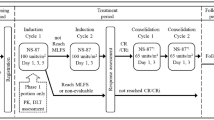Abstract
A phase I study of mitomycin C with menadione (2-methyl-1,4-naphthoquinone, a vitamin K analogue which lowers intracellular pools of reduced glutathione) was designed as an approach to overcoming tumor cell resistance to alkylating agent chemotherapy. Patients with refractory solid tumors (n=51) were treated with a 48-h continuous intravenous infusion of menadione followed by a bolus intravenous dose of mitomycin C at the completion of the menadione infusion. Initial menadione doses of 8.0 and 4.0 g/m2 over 48 h were associated with hemolysis, so subsequent dose levels of menadione ranged from 1.0 to 3.0 g/m2 with mitomycin C from 5 to 20 mg/m2. All three patients treated with menadione at 8.0 g/m2 and the single patient treated at 4.0 g/m2 with mitomycin C at 5 mg/m2 developed clinically significant hemolysis despite the presence of red blood cell glucose-6-phosphate dehydrogenase. Subsequently, a revised escalation scheme for menadione was used, and all patients tolerated menadione doses of 1–2.5 g/m2 over 48 h with mitomycin C doses up to 20 mg/m2. Since the 3.0 g/m2 dose of menadione was associated with mild hemolysis in three of four patients, the maximum tolerated dose of menadione was established at 2.5 g/m2. All of the mitomycin dose levels were tolerated without unexpected toxicities attributable to the combination. Prolonged infusions of menadione at doses which have been associated with lowering of intracellular glutathione pools in short-term exposure are limited by dose-dependent hemolysis, probably due to depletion of erythrocyte glutathione by menadione-related redox cycling. There was no detectable deleterious effect of pre-exposure to menadione on mitomycin C tolerance. We recommend a combination of menadione at 2.5 g/m2 as a continuous intravenous infusion and mitomycin C at 15 mg/m2 for further study in solid tumors for which treatment with single-agent mitomycin C is appropriate.
Similar content being viewed by others
References
Akman SA, Doroshow JH, Dietrich MF, Chlebowski RT, Block JS (1987) Synergistic cytotoxicity between menadione and dicumarol vs. murine leukemia L1210. J Pharmacol Exp Ther 240: 486
Akman S, Carr B, Leong L, Margolin K, Odujinrin O, Doroshow J (1988) Phase I trial of menadiol sodium diphosphate (SYN-KAVITE•) (M) in advanced cancer. Proc Am Soc Clin Oncol 7: 76
Bailey HH, Mulcahy RT, Tutsch KD, Arzoomanian RZ, Alberti D, Tombes MG, Wilding G, Pomplun M, Spriggs DR (1994) Phase I clinical trial of intravenous L-buthionine sulfoximine and melphalan: an attempt at modulation of glutathione. J Clin Oncol 12: 194
Chlebowski RT, Block JB, Dietrich M, Octay E, Barth N, Yanagihara R, Gota C, Ali I (1983) Inhibition of human tumor growth and DNA biosynthetic activity by vitamin K and warfarin in vitro and clinical results. Proc Am Assoc Cancer Res 24: 653
Chlebowski RT, Akman SA, Block JB (1985) Vitamin K in the treatment of cancer. Cancer Treat Rev 12: 49
Chlebowski RT, Dietrich M, Akman S, Block JB (1985) Vitamin K3 inhibition of malignant murine cell growth and human tumor colony formation. Cancer Treat Rep 69: 527
Di Monte D, Ross D, Bellomo G, Eklöw L, Orrenius S (1984) Alterations in intracellular thiol homeostasis during the metabolism of menadione by isolated rat hepatocytes. Arch Biochem Biophys 235: 334
Doroshow JH (1986) Role of hydrogen peroxide and hydroxyl radical formation in the killing of Ehrlich tumor cells by anticancer quinones. Proc Natl Acad Sci USA 83: 4514
Doroshow J, Burke T (1988) Resistance to anticancer quinone-induced cytotoxicity produced by introduction of glutathione-S-transferase (GST) into human MCF-7 breast cancer cells. Proc Am Assoc Cancer Res 29: 271
Dorr RT (1988) New findings in the pharmacokinetic, metabolic, and drug-resistance aspects of mitomycin C. Semin Oncol 15: 32
Dusre L, Rajagopalan S, Eliot HM, Covey JM, Sinha BK (1990) DNA interstrand cross-link and free radical formation in a human multidrug-resistant cell line from mitomycin C and its analogues. Cancer Res 50: 648
Keizer H, De Leeuw SJ, Van Rijn J, Pinedo HM, Joenje H (1989) Effect of artificial electron acceptors on the cytotoxicity of mitomycin C and doxorubicin in human lung tumor cells. Eur J Cancer Clin Oncol 25: 1113
Lesesne B, Rothschild N, Erickson B, Korec S, Sisk R, Keller J, Arbus M, Woolley PV, Chiazze L, Schein PS, Neefe JR (1989) Cancer-associated hemolytic-uremic syndrome: analysis of 85 cases from a national registry. Clin Oncol 7: 781
Nagourney R, Weisenthal L, Dill P, Just R, Fass L, Baker J (1987) Menadiol in combination with cytotoxic chemotherapies; the feasibility for resistance modification in human cancers: a pilot study. Proc Am Soc Clin Oncol 6: 35
O'Dwyer PJ, Hamilton TC, Young RC, LaCreta FP, Carp N, Tewk KD, Padavic K, Comis RL, Ozols RF (1991) Depletion of glutathione in normal and malignant human cells in vivo by buthionine sulfoximine: clinical and biochemical results. J Natl Cancer Inst 84: 264
Parekh HK, Mansuri-Torshizi H, Srivastava TS, Chitnis MP (1992) Circumvention of adriamycin resistance: effect of 2-methyl-1,4-naphthoquinone (vitamin K3) on drug cytotoxicity in sensitive and MDR P388 leukemia cells. Cancer Lett 61: 147
Pritsos CA, Sartorelli AC (1986) Generation of reactive oxygen radicals through bioactivation of mitomycin antibiotics. Cancer Res 46: 3528
Su Y-Z, Duarte TE, Dill PL, Weisenthal LM (1987) Selective enhancement by menadiol of in vitro drug activity in human lymphatic neoplasms. Cancer Treat Rep 71: 619
Xu BH, Singh SV (1992) Effect of buthionine sulfoximine and ethacrynic acid on cytotoxic activity of mitomycin C analogues BMY 25282 and BMY 25067. Cancer Res 52: 6666
Author information
Authors and Affiliations
Rights and permissions
About this article
Cite this article
Margolin, K.A., Akman, S.A., Leong, L.A. et al. Phase I study of mitomycin C and menadione in advanced solid tumors. Cancer Chemother. Pharmacol. 36, 293–298 (1995). https://doi.org/10.1007/BF00689046
Received:
Accepted:
Issue Date:
DOI: https://doi.org/10.1007/BF00689046




